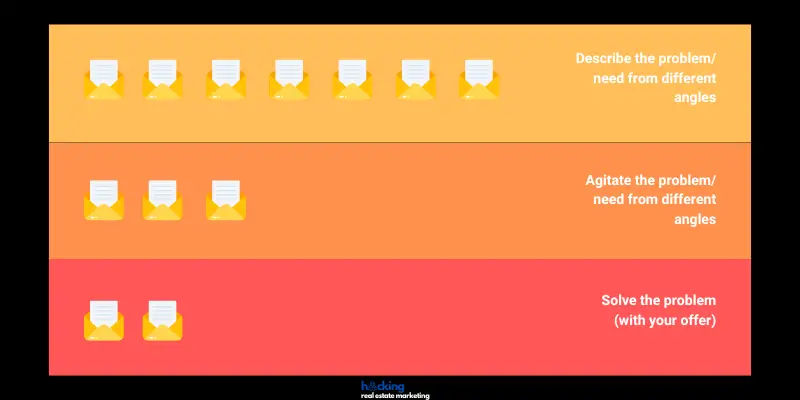One thing is knowing that real estate email marketing is beneficial to lower costs per lead, and another thing is finding real estate email ideas and what content to use in an email sequence.
You can find loose real estate email ideas all across the web.
However, you usually don’t find a strategic system for generating and aligning them to a seller or buyer prospect’s problems or needs.
Therefore, this article will provide a real estate email ideas formula that will hopefully help you increase your email open rates.
4 Types of Email Sequences for Real Estate
I won’t go into the best practices for writing an email for your email marketing campaign in this article.
I already covered this topic here.
And I won’t go into the strategy of how to grow an email list for real estate.
This time, it’s more about ideas and the email content you can use.
But to do this systematically, you first want to know about the different types of email sequences.
Why?
The type of sequence you select based on your goals for your real estate email marketing informs the content you want to use.
From the various sequences you can find, I identified the ones relevant to real estate, and below are the five common types you can choose from.
The Welcome Sequence
You can set up this short sequence for real estate leads that just entered your email list.
Think of this sequence’s purpose as the first orientation of your new lead and also to probe if the new lead may be already warm enough to take some immediate action.
The first email of a welcome sequence is typically sent immediately after a new lead enters your real estate funnel.
And if you offered a real estate lead magnet in exchange for their email address, you also sent it in this first email.
You can also shortly mention what you can do for the lead.
Ideally, you should align your offer with the lead magnet to stay relevant.
For example, suppose the lead magnet is a short home buyer’s guide with important information on qualifying for a loan.
In that case, you may provide a call scheduling link to get a first consultation to get started with a loan.
The person doing the consultation call can be you, provided you are qualified for that, or a loan officer you are working with.
You can consider this sequence as best practice for any other type of email sequence.
The duration of this sequence is rather short and may go on for just a few weeks or days.
The Nurture and Conversion Sequence
As part of the name already reveals, the purpose of the nurture and conversion email sequence is to convert warm leads into hot ones that take action and become your clients.
This one will be the most used and can go for as long as the real estate sales cycle usually takes – several months up to 18 months.
The Re-Engagement Sequence
This is a short email sequence (under a month-long), and you can think of it as a resuscitation procedure for “dead” real estate leads.
The purpose is to bring the “dead” leads back to warm them up or to clean up your email list to keep it healthy.
The latter aspect is essential if you want to keep your email marketing provider happy.
Hence, you get fewer spam complaints but also don’t pay for many subscribers that don’t do anything.
Email marketing providers often charge their monthly fees based on the number of subscribers you have.
The Reminder & Follow-Up Sequence
Both sequences are pretty similar.
They are also short and usually relate to an event the leads need to be followed up on or reminded of.
The event can be communication that couldn’t be established via phone or text outreaches or literal events such as open house events or webinars.
How Real Estate Email Sequences Inform the Email Ideas and Content
In a fantasy world, you wouldn’t even need email marketing.
Why?
Because a website visitor would see your service offer as a real estate agent and sign a listing contract or buy a property right on the spot online, no questions asked.
We both know this world doesn’t exist.
However, I mention this to better illustrate all email sequences’ goal: converting leads into customers.
For the next section, think of email sequences as long-form sales letters broken up into several pieces, sent over time, supplemented with more informational and helpful content, and written in a more personal style.
This means a big part is copywriting, and the other one is content writing.
It’s a “dance” between informational and promotional content.
To plan and design the email sequence, you can apply copywriting formulas on a macro level to the whole sequence informing the real estate email content ideas you use.
On the micro level – the email outline and structure itself, even when the email content is not promotional.
The Real Estate Email Ideas Formula
So, from the above, we learned that the email sequence will contain informational and promotional emails that aim to convert leads into customers.
The latter ones should also use sales copy elements for the email content.
You want to use more informational content than promotional to not scare away the leads you collect.
A best practice is using between 10% and 20% promotional and 90% to 80% informational content.
Let’s use an example and apply the copywriting formula PAS (problem, agitate, solve) on the macro level of a real estate email sequence.
You can use this technique also with other formulas.
Still, this formula is easy for designing a whole email sequence.
While it’s not an optimal frequency, suppose you want to send one email monthly over 12 months.
You can read why this is not an optimal frequency in my article here.
The “problem” and “agitate” parts of the formula aren’t promotional content yet.
Only the “solve” part is where you present your solution (your service or product).
However, you may also mention in passing what you offer in informational content, but to keep it informational, you want to do this softly (soft selling).
Using 20% promotional emails over the 12 months would be 2.4 emails.
Let’s round that down to two.
So you would need to create real estate ideas for 10 informational and 2 promotional emails.
As a sequence, it could be seven emails describing the problem or need from different angles, three emails agitating the problem or need from different angles, and two promotional emails that solve the problem (with what you have to offer).

It’s better to not overdo the agitating part too much, though.
Remember that in promotional emails, you can use all the elements of good copywriting (e.g., testimonials, showing your USP, urgency, etc.).
Now, we can start with concrete real estate email ideas.
And guess where you can get all the email ideas you need?
Do you already do content marketing and write articles or produce videos or other content on social media?
If yes, you can identify relevant content and repurpose it for your email sequence.
But don’t forget to align this content with the initial reasons why a buyer or seller prospect opted into your email list.
Luckily, this article has covered more than 254 real estate content ideas.
You can get your first inspiration for real estate email ideas from different formats, such as…
- Definition article/email content
- Theory or argument
- List content
- Technical blueprint
- “How to” content/guidance
- Generous email (e.g., a booklet attached)
- Self-revelation
- Too good to be true email
- Overview
- Entertaining email
- News hijacking
- Use case
- Controversial
- Comparing X with Y
- Research
- Motivational
- Research
- What-if
- FAQs
- Questions you should ask when
- Interviews
- Open question
- Existing debate
In the article mentioned above, you can find more content formats you can use.
I selected the most relevant ones that could be used for email ideas.
As you may have noted, these formats are still pretty generic and can be applied to all industries when it comes to content for email marketing or content for articles, videos, and more.
So, you need to combine the formats with the relevant real estate topics aligned with the lead magnet or incentive you use to generate leads.
Let’s have an example and use the lead magnet from above again: a buyer’s guide with important information on how to qualify for a loan.
So, the need or problem is likely that a potential buyer hasn’t qualified for a loan yet, but wants to buy a property soon.
Below I added a table with real estate email ideas you could use for the content aligned with the buyer’s problem or need using the PAS copywriting formula to design the sequence.
These are only the ideas and, by far, no headlines (they would make pretty crappy headlines, by the way).
| Problem (informational) | Agitate (informational) | Solve (promotional) |
|---|---|---|
| Questions to ask yourself to determine if you are ready to buy | 3 Likely things that may happen if you don't apply for a loan this year | Our newest properties in XYZ for first-time homebuyers (Owner Financing Available) |
| Saving for a down payment | How working with the wrong loan officer can cost you dearly | Get to know our vetted loan officers |
| When you should not apply for a loan | How staying in a rental apartment may become pretty expensive in the future | |
| The closing process after you are approved for a loan | ||
| 7 Negotiating tips | ||
| 10 Common pitfalls most buyers make when applying for a loan | ||
| How to speed up the process |
This article has been reviewed by our editorial team. It has been approved for publication in accordance with our editorial policy.
- Why Real Estate Conversion Rates Are 6-Times Below Average - March 21, 2024
- How to Manage Your Apartment Advertising Campaign - February 23, 2024
- Finding Marketing Channels for Apartment Advertising - February 12, 2024

